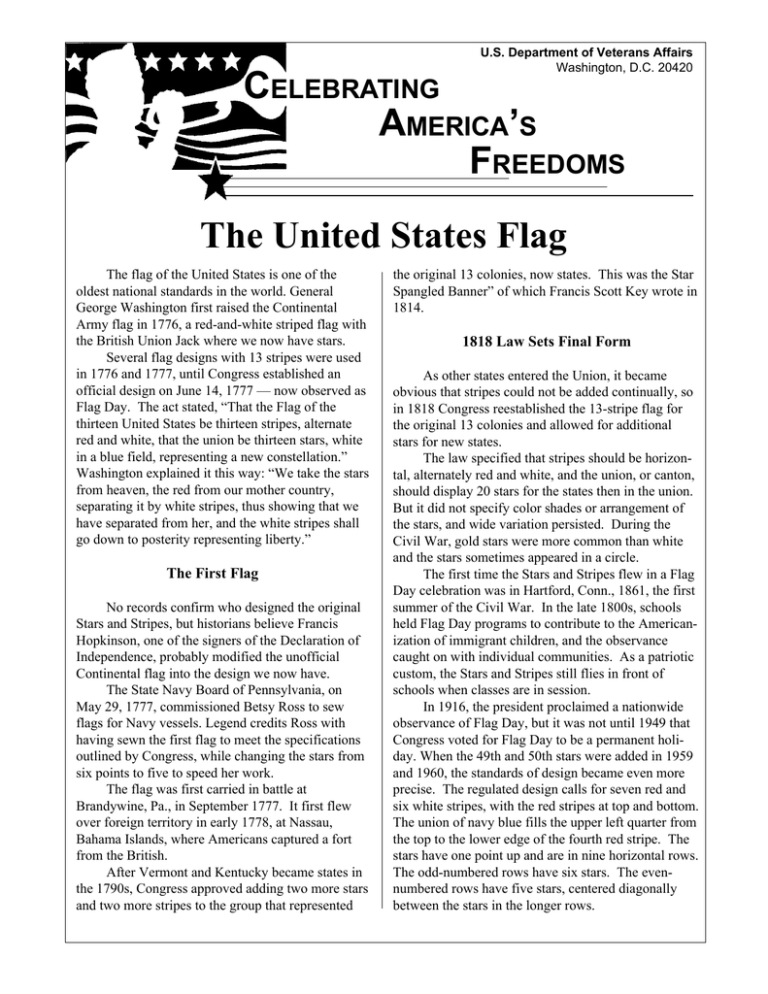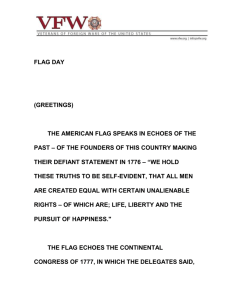C A ’ F
advertisement

U.S. Department of Veterans Affairs Washington, D.C. 20420 CELEBRATING AMERICA’S FREEDOMS The United States Flag The flag of the United States is one of the oldest national standards in the world. General George Washington first raised the Continental Army flag in 1776, a red-and-white striped flag with the British Union Jack where we now have stars. Several flag designs with 13 stripes were used in 1776 and 1777, until Congress established an official design on June 14, 1777 — now observed as Flag Day. The act stated, “That the Flag of the thirteen United States be thirteen stripes, alternate red and white, that the union be thirteen stars, white in a blue field, representing a new constellation.” Washington explained it this way: “We take the stars from heaven, the red from our mother country, separating it by white stripes, thus showing that we have separated from her, and the white stripes shall go down to posterity representing liberty.” The First Flag No records confirm who designed the original Stars and Stripes, but historians believe Francis Hopkinson, one of the signers of the Declaration of Independence, probably modified the unofficial Continental flag into the design we now have. The State Navy Board of Pennsylvania, on May 29, 1777, commissioned Betsy Ross to sew flags for Navy vessels. Legend credits Ross with having sewn the first flag to meet the specifications outlined by Congress, while changing the stars from six points to five to speed her work. The flag was first carried in battle at Brandywine, Pa., in September 1777. It first flew over foreign territory in early 1778, at Nassau, Bahama Islands, where Americans captured a fort from the British. After Vermont and Kentucky became states in the 1790s, Congress approved adding two more stars and two more stripes to the group that represented the original 13 colonies, now states. This was the Star Spangled Banner” of which Francis Scott Key wrote in 1814. 1818 Law Sets Final Form As other states entered the Union, it became obvious that stripes could not be added continually, so in 1818 Congress reestablished the 13-stripe flag for the original 13 colonies and allowed for additional stars for new states. The law specified that stripes should be horizontal, alternately red and white, and the union, or canton, should display 20 stars for the states then in the union. But it did not specify color shades or arrangement of the stars, and wide variation persisted. During the Civil War, gold stars were more common than white and the stars sometimes appeared in a circle. The first time the Stars and Stripes flew in a Flag Day celebration was in Hartford, Conn., 1861, the first summer of the Civil War. In the late 1800s, schools held Flag Day programs to contribute to the Americanization of immigrant children, and the observance caught on with individual communities. As a patriotic custom, the Stars and Stripes still flies in front of schools when classes are in session. In 1916, the president proclaimed a nationwide observance of Flag Day, but it was not until 1949 that Congress voted for Flag Day to be a permanent holiday. When the 49th and 50th stars were added in 1959 and 1960, the standards of design became even more precise. The regulated design calls for seven red and six white stripes, with the red stripes at top and bottom. The union of navy blue fills the upper left quarter from the top to the lower edge of the fourth red stripe. The stars have one point up and are in nine horizontal rows. The odd-numbered rows have six stars. The evennumbered rows have five stars, centered diagonally between the stars in the longer rows. U.S. Department of Veterans Affairs Washington, D.C. 20420 CELEBRATING AMERICA’S FREEDOMS “Old Glory” The name “Old Glory” was first applied to the U.S. flag by a young sea captain who lived in Salem, Mass. On his twenty-first birthday, March 17, 1824, Capt. William Driver was presented a beautiful flag by his mother and a group of local young ladies. Driver was delighted with the gift. He exclaimed, “I name her ‘Old Glory.’” Then Old Glory accompanied the captain on his many voyages. Captain Driver quit the sea in 1837 and settled in Nashville, Tenn. On patriotic days, he displayed Old Glory proudly from a rope extending from his house to a tree across the street. After Tennessee seceded from the Union in 1861, Captain Driver hid Old Glory by sewing the flag inside a comforter. When Union soldiers entered Nashville on February 25, 1862, Driver removed Old Glory from its hiding place, carried the flag to the state capitol building, and proudly raised it for all to see. Shortly before his death, the old sea captain placed a small bundle into the arms of his daughter. He said to her, “Mary Jane, this is my ship flag, Old Glory. It has been my constant companion. I love it as a mother loves her child. Cherish it as I have cherished it.” The flag remained as a precious heirloom in the Driver family until 1922. Then it was sent to the Smithsonian Institution in Washington, D.C., where it is carefully preserved under glass today.





